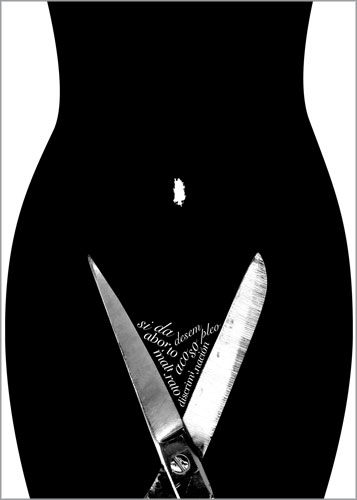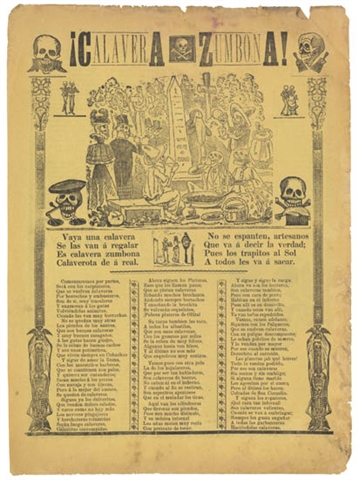
Posters and the Art of Social Protest
A set of new shows at UTEPs Rubin Center links poster art to its history as populist agitprop and interpretation, and considers 12 leading graphic artists (one a collective), who are using poster art to reconstitute comment, dissent and protest through visuality.
Convene in your imagination a history of political graphic art that helped sell the aims of the Mexican Revolution on the streets a century ago, and the contemporary situation of new graphic posters. What you have is the big-stick-carrying set of exhibits opening April 15 at the Rubin Center of University of Texas at El Paso.

Poster for Ljubljana poster festival designed by Lukatarina.
A hundred years ago this year the Mexican dictator Porfirio Diaz was enjoying an eighth self-appointed term as President — a cabal shortly to come to a close, after Francisco Madero unleashed the Mexican Revolution in November 1910.
Last year in Ljublana, Slovenia site not very long ago of civil war in the Balkans a poster art festival organized to galvanize visual responses to cliamte change convened international graphic artists to demonstrate how the poster is a still vital mechanism of communicating what Shephard Fairey might know as the power of HOPE.
Given UTEPs border city location and connection to Mexico, plus what Rubin Center curator and director Kate Bonansinga identified as the gallerys mission to show contemporary art, the University graphics department faculty (Antonio Castro, Clive Cochran, Anne Giangiulio and Albert Wong) worked with Bonansinga on commemorating the Mexican Revolutions centennial with an invitational contemporary graphic arts exhibit, Up Against the Wall, featuring 12 leading graphic artists, plus one graphic arts collective, all of whom are using poster art to reconstitute comment, dissent and protest through visuality.

Lourdes Zolezzi poster on femicide in Juarez
Alongside the contemporary designs of Up Against the Wall are historical precedents from Mexico comprising a roughly 400 square foot show, “Solidarity and Struggle,” which includes 1910-1913 graphics by Jose Guadalupe Posada, one of the Mexican revolutionary periods most influential artists, and some of his peers.
These works, reproduced in a Mexican magazine from the early 20th century, are being loaned by UTEP. University of New Mexico weighs in to the historical graphics mix by loaning the show prints by artists who were part of the collective Taller Grafica Popular.The earliest TGP print in the show dates from 1938; the eldest from 1979, with the majority set in the 1940s and 50s, said Bonansinga in an interview. (above: Lourdes Zolezzi commentary on femicide in Juarez.)
This mechanism of juxtaposing, for denizens of El Paso and visitors, cutting-edge work in contemporary poster art with a look at the ways revolutionary struggle was communicated through populist means in the past, makes this show an interesting litmus both of Mexican Revolution history and the current violent scenarios making headlines about drug cartel-related deaths just over the El Paso border in Juarez. Bonansinga stressed that planning for this show began in 2008, but acknowledged “it is an intense time to be having a show like this.”

“My greatest hope for this exhibition,” Bonansinga said, ” is it will encourage people to question the status quo and be politically and socially active. The show speaks to themes even broader and more universal than our specific situation here on the border — though (that) certainly applies.”
While Jose Guadalupe Posada managed to promote the revolutionary enterprise via “penny broadsides,” newsprint circulars that would be sold in the street for a penny, and that aided through the use of a mythic symbology to help the disowned peasants of Mexico find their voices in a local struggle that coincided with revolutionary fracas around the globe, what is clear in this era is that to design a slogan that grabs hold of people can still be both a game changer (viz, Barack Obama) and a salute to the power of words and images that stick.
Of the 12 artists in the show the best known might be Milton Glaser famous for the I Heart NY poster which Glaser revised to read I Heart NY More Than Ever, after 9-11. Milton Glaser this year was awarded a presidential medal of arts from Pres. Barack Obama and offered to visitors that he wished his mother could be there to see it.

Jose Guadalupe poster
Israel artist Yossi Lemel of Tel Aviv spoke at UTEP on 4/13 and has been a voice through hard-to-look-at images, like hanks of raw meat with bloody stitches, of the Israel-Palestine issue He is co-curator of the international traveling exhibition and book Both Sides of Peace: Israeli and Palestinian Political Poster Art (Contemporary Art Museum, Raleigh, NC).
The other artists are Fang Chen (Chinese), Seymour Chwast a business partner of Milton Glaser whose image in the show dates from the Vietnam era, Paul Davis, Brad Holland, Luba Lukova, Alejandro Magellanes, Mirko Ilic, Joe Scorsone/Alice Dreuding, Lanny Sommese, James Victore and Lourdes Zolezzi.
(top photo: From the Taller de Grafica Popular, a photo of posters used during 1942-43: The Second World War – “A corner of 5th of May Avenue, with poster by Pablo OHiggins; Leopoldo Méndez portrait of Marshal Timoshenko; Alfredo Zalce: “The USSR is defending the Freedom of the World. Lets help.” Bob Mallary, Nazi New Order.”)
